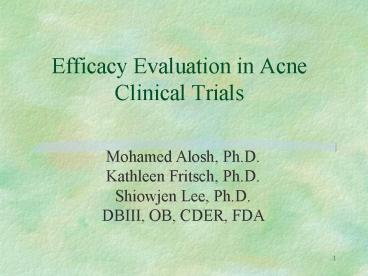Efficacy Evaluation in Acne Clinical Trials - PowerPoint PPT Presentation
1 / 30
Title:
Efficacy Evaluation in Acne Clinical Trials
Description:
are similar, as for X (but here less signif.) no general pattern for ranks vs. original data ... Comments about efficacy results by baseline category ... – PowerPoint PPT presentation
Number of Views:298
Avg rating:3.0/5.0
Title: Efficacy Evaluation in Acne Clinical Trials
1
Efficacy Evaluation in Acne Clinical Trials
Mohamed Alosh, Ph.D. Kathleen Fritsch, Ph.D.
Shiowjen Lee, Ph.D. DBIII, OB, CDER, FDA
2
An Outline
- 1. Re-visit choice of primary endpoints
- (statistical viewpoint)
- 2. Statistical analysis methods and
data transformations - 3. Repeated measurements vs. final assessment
- 4. Effect of baseline severity
- 5. Final Comments
3
1. Primary Endpoints in Acne Trials (Statistical
Viewpoint)
- Inflammatory, non-inflammatory, and Total Lesion
Counts can be analyzed as - final lesion counts
- change from baseline
- percent change
- Investigator Global Evaluation (IGE)
4
Analysis of Change Scores
- Pros
- Easy to interpret analyze
- Attempts to remove influence of baseline counts
- Cons
- Baseline may still have influence since change is
negatively correlated with final counts - Change and percent change scores may have highly
skewed distributions (violates parametric tests)
5
Figure 1. Mean Lesion Counts by Type over
Time(Drug X, Study 1)
6
Figure 2. Mean Lesion Counts by Type over
Time(Drug Y, Study 2)
7
Figure 3. Inflammatory Counts at Week 12 vs.
Baseline Count (Drug X, Vehicle Arm)
8
Figure 4. Inflammatory Counts at Week 12 vs.
Baseline Count (Drug X, Active Arm)
9
Figure 5. Mean Change in Infl. Lesions over
Time (Drug X, Study 1)
10
Figure 6. Subjects Total Lesion Count over Time
-- Center A (Drug X, Study 1)
11
2. Statistical Analysis Issues
- (a) Analysis units
- original
- transformed data (ranks, log, etc.)
- (Pros Cons)
- (b) Analysis methods for final study endpoint
- Simple comparisons
- ANOVA (treatment, center, interaction)
- ANCOVA (include baseline count as covariate)
- (Comparison of results presented in Tables 1a-c
Tables 2a-c)
12
3. Repeated Measures vs. Final Assessment
- Repeated measures may increase power for
detecting treatment effect - Must select number of timepoints to be included
in repeated measurements model - Repeated Measures Models
- MANOVA, GLM, MIXED
- (Comparison of results presented in Tables 1a-c
Tables 2a-c))
13
Table 1a Treatment effect p-values for various
statistical methods (Drug X, Study 1)
(active, vehicle) (R) Repeated Measures
14
Table 1b Treatment effect p-values for various
statistical methods (Drug X, Study 1)
(active, vehicle) (R) Repeated Measures
15
Table 1c Treatment effect p-values for various
statistical methods (Drug X, Study 1)
(active, vehicle) (R) Repeated Measures
16
Comments on Results for Drug X
- results for total are similar to non-infl.
(strong corr., highly signif.) - no general pattern for ranks vs. original data
- for infl. lesions, change has smaller
p-values than counts or change - for change and change, ANCOVA has similar
results to Week 12 analysis - p-values for rep. meas. in general are larger
than final study endpoint analysis (prev. weeks
not signif.)
17
Table 2a Treatment effect p-values for various
statistical methods (Drug Y, Study 2)
(active, vehicle) (R) Repeated Measures
18
Table 2b Treatment effect p-values for various
statistical methods (Drug Y, Study 2)
(active, vehicle) (R) Repeated Measures
19
Table 2c Treatment effect p-values for various
statistical methods (Drug Y, Study 2)
(active, vehicle) (R) Repeated Measures
20
Comments on Results for Drug Y
- results for total non-infl. are similar, as
for X (but here less signif.) - no general pattern for ranks vs. original data
- for infl. lesions, change has larger
p-values than counts or change - for change and change, ANCOVA has similar
results to Cycle 6 analysis - p-values for GLM(R)/ANCOVA(R) in general are
smaller than final study endpoint
21
4. Effect of Baseline Severity
- Divide subjects into equal sized groups (e.g.,
quartiles) based on baseline lesion count - Plots of lesion counts by baseline category
- Compare efficacy results by baseline category
- Tables 3a-b present results for lesion counts
- Tables 4a-b present results for IGE
22
Figure 7. Mean Week 12 Lesion Counts by Type over
Baseline Category (Drug X, Study 1)
23
Figure 8. Mean Cycle 6 Lesion Counts by Type over
Baseline Category (Drug Y, Study 2)
24
Table 3.a. Treatment Effect at Week 12 by
Baseline Category (Drug X, Study 1)
25
Table 3.b. Comparison of IGE Success Rates at
Week 12 by Baseline Category (Drug X, Study 1)
Success None or Minimal Acne
26
Table 4.a. Treatment Effect at Cycle 6 by
Baseline Category (Drug Y, Study 2)
27
Table 4.b. Comparison of IGE Success Rates by
Baseline Category (Drug Y, Study 2)
Success Clear or Almost Clear/Mild
28
Comments about efficacy results by baseline
category
- For the two drugs considered, no general pattern
for results for lesion counts by type, their
change, or percent change - Similarly, for the two drugs considered, there is
also no general pattern for the IGE - For the range of lesion counts in these studies,
efficacy results do not appear to vary by
baseline severity
29
5. Final Comments
- (a) Analysis of change from baseline, percent
change, and final counts with baseline as
covariate attempt to account for variability at
baseline - (b) Percent change data could have extreme
outliers when the baseline count is relatively
small (e.g., inflammatory lesions)
30
Final Comments (contd)
- (c) Repeated measurements approach attempts to
reduce the influence of outliers (flares) by
averaging over time. - The impact of the repeated measures on the
p-value depends on whether efficacy reached a
plateau at previous time points. - (d) For the data sets considered, treatment
efficacy did not vary by baseline severity
whether one considers analysis of lesion counts
or IGE

